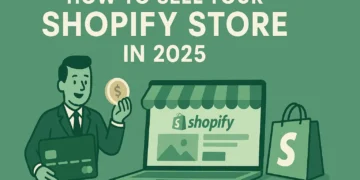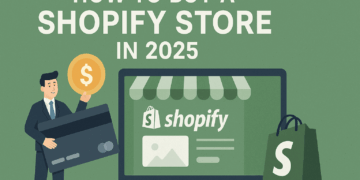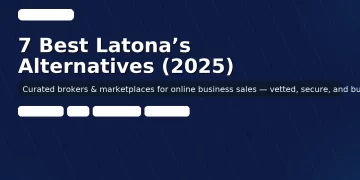If you are considering selling your SaaS business, you are likely sitting on a highly valuable asset. SaaS businesses, known for their recurring revenue streams and scalable models, are in high demand among prospective buyers. However, the process of selling such a company can be both complex and time-consuming.
Whether you aim to leverage the growing demand for B2B SaaS solutions or are ready to move on to your next venture, understanding the right strategies is essential for achieving a successful sale.
In markets like the United States and the United Kingdom, SaaS businesses are thriving, with buyers actively seeking companies offering strong annual recurring revenue (ARR) and low customer churn rates. To sell your SaaS business quickly and at the best price, you need to be thoroughly prepared and informed about every step of the process—from valuation and marketing to negotiation and closing the deal.
This guide will provide you with the key strategies needed to sell your SaaS business efficiently. You will learn about business valuation, optimizing operations, selecting the right sales channels, and effective marketing. By the end, you will have a clear roadmap to ensure your SaaS business sale is both successful and profitable.
Understanding Your SaaS Business Valuation

Determining Your Business’s Worth
Valuing a SaaS business is a complex process that involves several key metrics and factors. Unlike traditional businesses, SaaS companies are often valued based on their recurring revenue streams, growth potential, and other unique financial and operational metrics.
To determine your business’s worth, you need to understand the various valuation methods commonly used in the SaaS industry.
One of the most prevalent methods is the use of revenue multiples, particularly the Enterprise Value (EV) to Revenue multiple. This metric compares the total value of your company to its annual revenue.
For example, if your SaaS company generates $10 million in annual revenue and the EV/Revenue multiple is 5.0x, your company would be valued at $50 million.
Another important metric is the Annual Recurring Revenue (ARR) multiple. This method is especially relevant for companies with strong recurring revenue streams and high growth rates.
Investors often look for ARR greater than $2 million with year-over-year growth rates exceeding 50% to justify higher valuations.
Factors Influencing SaaS Valuation
Several factors influence the valuation multiples of a SaaS business. The age of the company, for instance, plays a significant role. Companies with a longer track record of sustainable earnings typically receive higher valuation multiples compared to newer startups.
A company that has been operating for more than three years is generally viewed as more stable and predictable, leading to higher multiples.
Growth rate is another critical factor. Investors are attracted to companies with sustainable and predictable growth rates. A high and consistent growth rate indicates strong revenue progression and capital efficiency, making the company more valuable.
Market trends and customer metrics are also important. Being in a consistently trending market with sustainable growth is more appealing than being in a rapidly growing but unpredictable market.
Customer metrics such as churn rate and customer lifetime value (LTV) are closely watched by investors. A low churn rate and high LTV indicate a healthy and valuable customer base.
The Rule of 40, which combines a company’s growth rate and profitability metric, is another benchmark. If a company’s score exceeds 40%, it is often associated with higher valuations.
Additionally, factors like net revenue retention (NRR), gross margin, and cash flow management are essential in assessing the overall value of a SaaS company.
Finally, the customer acquisition cost (CAC) and the LTV/CAC ratio are vital metrics. A high LTV/CAC ratio indicates that the company is generating more revenue from each customer than it spends to acquire them, which is a strong signal of financial health and growth potential.
Get the best price for your business — we take care of the rest.
Start Selling for FreeOptimizing Business Operations

Improving Recurring Revenue Streams
To attract prospective buyers and maximize the valuation of your SaaS business, it is necessary to optimize your recurring revenue streams. One of the key strategies is to focus on reducing customer churn and improving customer retention. This can be achieved by enhancing the user experience and ensuring that your product meets the evolving needs of your customers.
Implementing a robust onboarding process, as mentioned in SaaS growth strategies, can significantly impact activation rates and long-term customer satisfaction.
Another approach is to optimize your pricing strategy. Offering tiered pricing models or user-based licensing can help align your revenue with the value your customers derive from your product.
For instance, switching to a user-based licensing model where you only pay for active users can help in reducing unnecessary costs and increasing the overall efficiency of your revenue generation.
Additionally, expanding your product offerings through integrated services or additional features can increase the average revenue per user (ARPU). This could include offering payment processing services, as seen in some SaaS companies, which can provide an additional revenue stream and enhance the overall value proposition of your product.
Streamlining Operational Efficiency
Streamlining operational efficiency is vital for presenting your SaaS business as a well-managed and scalable entity to potential buyers. This involves conducting regular audits of your SaaS applications to identify and eliminate unused, redundant, or underutilized tools. Such audits help in reducing unnecessary spend and closing security gaps, thereby optimizing your SaaS portfolio.
Centralizing SaaS management is another critical step. By adopting a centralized approach, you can gain better visibility and control over your SaaS stack. This includes tracking software inventory, security incidents, and usage patterns in a single location, which helps in making informed decisions about your SaaS investments.
Improving SaaS integrations is also essential for enhancing operational efficiency. Integrating different SaaS applications can improve data flow and cross-departmental collaboration, reducing the friction and inefficiencies caused by data silos.
Identifying native integrations and implementing custom integrations where necessary can significantly boost productivity and operational efficiency.
Fostering SaaS literacy among your employees is another key aspect. Ensuring that your team is well-trained on the use of SaaS tools can maximize productivity and reduce the costs associated with underutilized software. Many SaaS providers offer free training programs that can be leveraged to achieve this goal.
Finally, implementing feedback loops and regular reviews with department heads can help in continuously identifying areas for improvement. This collaborative approach ensures that the needs of different business units are understood and addressed, leading to more efficient and effective SaaS operations.
Receive an instant valuation with our Ecommerce Business Valuation Tool.
Get My ValuationPreparing Your Business for Sale

Financial Documentation and Legal Preparations
To prepare your SaaS business for sale, it is essential to ensure that all financial documentation and legal requirements are in order. This includes compiling accurate and up-to-date financial statements, such as income statements, balance sheets, and cash flow statements, for at least the past three years.
Additionally, tax returns for the same periods are important for potential buyers to review.
Thorough legal preparation is also vital. Conduct a comprehensive review of all contracts, including customer agreements, vendor contracts, and employee agreements, to identify and address any unfavorable terms that could complicate the transaction. Ensuring that all agreements are well-documented and legally sound can prevent unexpected issues during due diligence.
This includes securing and documenting intellectual property (IP) rights, such as trademarks, patents, and copyrights, to reassure potential buyers of the long-term value of your business.
Organizing a data room, a secure online repository that stores all critical business documents, is another key step. This data room should include financial statements, contracts, user data, operational metrics, and any other information a potential buyer might need to evaluate your business.
A well-prepared data room expedites the due diligence process and demonstrates the transparency and organization of your business.
Building a Compelling Sales Memorandum
A sales memorandum, often referred to as an information memorandum or CIM (Confidential Information Memorandum), is a detailed document that tells the story of your SaaS business. This document is essential for attracting high-quality buyers and showcasing your business in the best light. It should include a comprehensive overview of your company, highlighting its unique value proposition, market position, customer base, revenue streams, and growth potential.
The sales memorandum should also outline your business model, including your revenue generation strategies, customer acquisition channels, and retention rates. Providing detailed metrics such as Monthly Recurring Revenue (MRR), Annual Recurring Revenue (ARR), customer churn rates, and customer acquisition costs (CAC) will help potential buyers understand the financial health and scalability of your business.
In addition to financial and operational details, the sales memorandum should include information about your team, technology, and intellectual property. Highlighting the expertise of your team, the robustness of your technology, and any proprietary software or algorithms can significantly enhance the perceived value of your business. Ensuring that this document is well-organized and clearly written will make it easier for potential buyers to understand the value and potential of your SaaS business.
Our AI recommends the best listings based on your investment profile.
Discover MilesChoosing the Right Sales Channel

Identifying the Best Platforms and Brokers
When it comes to selling your SaaS business, selecting the right sales channel is essential for attracting the right buyers and achieving the best possible price. One of the premier marketplaces for buying and selling online businesses, including SaaS companies, is Ecomswap. Ecomswap stands out as a top broker due to its extensive network of pre-vetted buyers and its expertise in creating compelling listings that attract serious buyers.
Ecomswap offers a comprehensive service that includes creating the perfect listing for your business, marketing it to a targeted audience, and managing the entire sales process. Their team of experts ensures that all listings are vetted and buyers are qualified, which reduces the risk of dealing with unserious or unqualified buyers.
Additionally, Ecomswap uses Letters of Intent (LOIs) and Escrow services to protect both the buyer and the seller, ensuring a smooth and secure transaction.
Direct vs. Brokered Sales: Pros and Cons
When deciding how to sell your SaaS business, you have two primary options: direct sales or using a broker like Ecomswap. Direct sales involve handling the entire process yourself, from marketing to negotiations. This approach can save you brokerage fees, but it also requires significant time and effort.
You will need to handle all the marketing, due diligence, and negotiations, which can be time-consuming and may distract you from running your business. Moreover, without the right network and expertise, you might struggle to attract high-quality buyers or achieve the best possible price.
On the other hand, using a broker like Ecomswap offers several advantages. Brokers have an extensive network of pre-qualified buyers, which increases the likelihood of attracting multiple offers and driving up the sales price through competition.
Ecomswap’s experienced team handles all aspects of the sale, from creating the listing to closing the deal, allowing you to focus on your business operations. Their expertise in the online business industry ensures that your business is presented in the best light, and the sales process is managed efficiently and professionally.
However, using a broker comes with a cost, as you will need to pay a brokerage fee. Despite this, many sellers find that the benefits, including higher sales prices and a smoother transaction process, outweigh the costs. For example, several entrepreneurs have praised Ecomswap for their ability to sell businesses quickly and for better prices than they could have achieved on their own.
Marketing Your SaaS Business

Creating a Strong Online Presence
Creating a strong online presence is essential for marketing your SaaS business effectively. This starts with a well-optimized website that is both user-friendly and search engine-friendly. Implementing robust SEO strategies, such as those outlined in SaaS SEO best practices, can significantly enhance your website’s visibility in search engine results pages (SERPs).
This includes optimizing title tags, meta descriptions, headings, and content to ensure your website ranks for relevant keywords.
A key aspect of a strong online presence is content diversification. Using a variety of content formats such as podcasts, webinars, infographics, and blog entries can help satisfy different customer preferences and expand your touchpoints with the target audience.
For example, creating in-depth industry guides and expert insights through whitepapers can demonstrate your company’s expertise and increase search volume and rankings.
Additionally, leveraging user-generated content, such as customer reviews and testimonials, can enhance trust and provide a consistent flow of new, keyword-rich content. This not only improves search engine exposure but also builds credibility with potential customers.
Utilizing Digital Marketing Strategies
Beyond SEO, utilizing various digital marketing strategies can help drive traffic and conversions for your SaaS business. Social media marketing is a powerful tool for building brand awareness and engaging with your audience.
Being active on platforms like Facebook, Twitter, LinkedIn, and Instagram can help you gain notice and consistently strengthen your brand’s identity online. Using proper hashtags and responding to user queries can improve your social media page discoverability and engagement.
Email marketing is another effective strategy. Building an email list and creating targeted campaigns can help you nurture leads and convert them into paying customers. Personalized email content that addresses specific pain points and offers valuable solutions can significantly improve conversion rates.
Content marketing, particularly through thought leadership, is also vital. Creating content that integrates your SaaS product into broader industry discussions can establish your company as an authority in the niche.
For instance, producing video content like Moz’s ‘Whiteboard Friday’ series can simplify complex topics, encourage high levels of interaction, and naturally incorporate relevant keywords.
Furthermore, leveraging forums, communities, and social media platforms to understand customer pain points and preferences can help you tailor your marketing efforts more effectively. Identifying recurring phrases or questions in these platforms can guide your content creation and keyword targeting, ensuring that you attract highly targeted and high-intent traffic.
Negotiating the Sale

Understanding the Buyer’s Perspective
Negotiating the sale of your SaaS business effectively requires a deep understanding of the buyer’s perspective. It is important to recognize that buyers are not just purchasing a product, but also investing in a relationship and a long-term partnership. Building strong relationships during negotiations is key to laying the groundwork for future collaborations and ensuring both parties are satisfied with the deal.
Understanding the buyer’s business needs and company culture is vital. During negotiations, take the time to ask probing questions to learn more about their challenges, goals, and values.
This approach helps in crafting solutions that fit their unique requirements, making your SaaS product an ideal fit for their needs. For instance, if you are negotiating with a healthcare provider, understanding their need for specific compliance features can help you tailor your offering to meet those needs.
Additionally, recognizing the emotional and psychological aspects of the buyer’s decision-making process is important. Using strategies like labeling, where you acknowledge and verbalize the buyer’s feelings and concerns, can build trust and empathy.
This approach ensures that the buyer feels heard and understood, which can significantly ease the negotiation process.
Tips for Effective Negotiation
To negotiate the sale of your SaaS business effectively, several key strategies can be employed. First, it is essential to start with a strong opening offer.
When a prospective buyer requests concessions, such as discounts or more favorable terms, respond strategically by asking for something in return. This sets the tone for the negotiation, indicating that you are not a pushover and preventing future requests for discounted pricing.
Active listening is another critical skill in successful negotiations. Top SaaS negotiators spend more time listening to the buyer and understanding their pain points rather than immediately extolling the product’s virtues. This approach allows you to align your solution perfectly with the buyer’s needs, setting up future negotiations for success.
Using a sales playbook can also enhance your negotiation skills. A well-prepared playbook includes resources such as statistics, data, examples, and case studies relevant to the prospect. This helps in addressing any questions or objections that arise during negotiations, ensuring you are always prepared to provide compelling evidence of your product’s value.
Transparency and honesty are also vital. Be clear about your terms, policies, features, benefits, and pricing. If you are unsure about an answer, it is okay to say so and promise to get back to the buyer.
This builds credibility and ensures that the buyer purchases for the right reasons, with all the necessary information.
Finally, consider the structure of the deal carefully. Options like upfront payments, earn-outs, or seller financing each have their pros and cons.
For example, seller financing can make the business more attractive to buyers by reducing their upfront capital requirement, but it also introduces repayment risk for the seller and delays the full realization of the sale price. Engaging a legal advisor can help ensure that your interests are protected in the sale agreement.
Closing the Deal Successfully

Finalizing the Sale: Legal and Financial Steps
Closing the deal on your SaaS business involves several critical legal and financial steps that must be carefully managed to ensure a smooth and successful transaction. The first step is to draft and sign a comprehensive sales contract, often referred to as the Sale and Purchase Agreement (SPA). This contract outlines all the details of the sale, including the purchase price, assets being transferred, payment terms, and any contingencies.
It is essential to hire a qualified attorney with experience in SaaS business sales to assist in drafting and reviewing this contract.
Non-disclosure agreements (NDAs) are also important at this stage. Ensure that all potential buyers have signed NDAs before sharing sensitive information about your business. This protects your intellectual property and trade secrets during the negotiation and due diligence process.
Financial considerations are another key aspect. Handle all financial details carefully, ensuring that funds are allocated according to the terms of the agreement and that all taxes are paid correctly. Consider the tax implications of the sale, as these can have significant effects on your financial outcome.
Working with a tax advisor or financial planner can help you navigate these complexities and minimize your tax liability.
The due diligence process is a thorough review of your business’s financial, legal, and technical aspects. This involves verifying financial statements, examining contractual obligations, and assessing compliance with laws and regulations.
Ensuring that all documentation is in order and that you are prepared to address any questions or concerns can streamline this process and build trust with the buyer.
Post-Sale Transition and Handover
After the sale is finalized, a smooth transition of ownership is essential to ensure the continued success of your SaaS business. This involves transferring all necessary assets, including intellectual property, customer contracts, and employee agreements, to the new owners. Providing training and support during this transition period can help the new owners understand the business operations, customer relationships, and any specific challenges they might face.
A transition period, where the previous owner provides support to the new owner, is often included in the sale agreement. This period can vary in length but typically involves introducing the new owners to key clients or partners, helping with any initial challenges, and ensuring a seamless handover of responsibilities. Defining the terms of this transition support period clearly in the Share Purchase Agreement is essential.
Non-compete agreements are also common in SaaS business sales. These agreements restrict the seller from starting a similar business or working with direct competitors for a specified period and in a defined geographic area.
While these agreements protect the buyer’s investment, it is important for the seller to ensure that the terms are fair and reasonable, and do not unduly limit future career opportunities.
Finally, post-sale financial planning is vital. The sale of your SaaS business can result in significant tax liabilities and new financial opportunities. Engaging with a financial advisor can help you manage your newfound wealth effectively, identify strategies to minimize tax liabilities, and guide you in investing and managing your post-sale finances.
Conclusion
Selling your SaaS business requires a meticulous and well-planned approach. To summarize, it is essential to understand your business’s valuation, optimize operations to enhance revenue streams and efficiency, and prepare your business for sale by ensuring all financial and legal documentation is in order. Choosing the right sales channel, such as working with a reputable broker like Ecomswap, and effectively marketing your business can significantly impact the success of the sale.
Understanding the buyer’s perspective and employing effective negotiation strategies are also key. Finally, ensuring a smooth transition post-sale will help maintain the value and continuity of your business.
Remember to focus on building a strong online presence, leveraging digital marketing strategies, and utilizing platforms that align with your business needs. By following these strategies, you can maximize the value of your SaaS business and attract serious buyers. Take action today by valuing your business accurately, streamlining your operations, and preparing for a successful sale.





